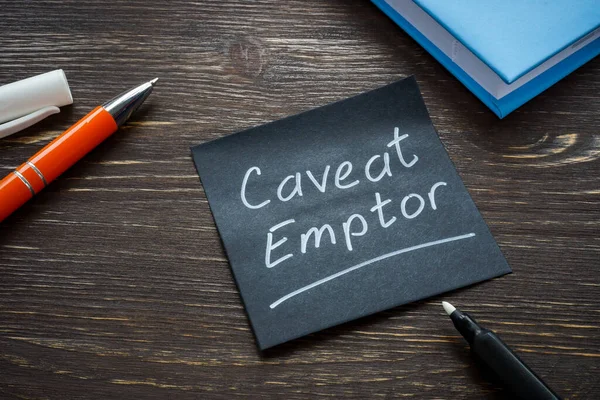This article has been written by Kavita Chandra and updated by Gautam Badlani. This article discusses the doctrine of Caveat emptor. Further, it analyses the gradual fall of the rule of caveat emptor and its replacement with the rule of caveat venditor (seller beware). This article also provides a summary of the landmark national and international judgments relating to caveat emptor.
It has been published by Rachit Garg.
Table of Contents
Introduction
Technological revolution and globalisation have led to a significant increase in the number of commercial transactions. The purchasing power of the consumers has increased manifold resulting in a large number of retail purchases. Laws have been enacted to make it mandatory for manufacturers to display the description of the product on the packaging cover. While the consumers have the right to inspect the description of the product before making the purchase, there are instances where the product conforms to its description but turns out to be of inferior quality and incapable of fulfilling the purpose for which it was purchased.
The issue that arises in such cases is whether the consumer has the right to return the inferior quality product or whether he is to bear the loss himself. The doctrine of caveat emptor states that the consumer takes a risk of quality and effectiveness when he purchases a product and if the product does not meet his expectations, then the consumer will himself be responsible for the inferior quality product. The consumer is expected to make a reasonable examination of the product’s quality and condition before making the purchase.
However, with time, the doctrine of caveat emptor was substituted by the doctrine of caveat venditor. Thus, there was a paradigm shift from ‘let the buyer beware’ to ‘let the seller beware’. This substitution was necessitated due to the changed circumstances of the modern world. The principle of caveat emptor is no longer applied by the judges who are now more inclined towards safeguarding the interests of the consumers.
The doctrine of caveat emptor evolved several decades ago and became a part of the common law. However, with the growth of trade and commerce, several exceptions to this principle were recognized by the policymakers.. Gradually, the exceptions became more prominent and significant than the rule itself.
History of the doctrine of caveat emptor
The principle of caveat emptor reflects the view of 19th-century society towards consumers. At that time, the interests of the businesses were prioritised over the interests of the consumers. Thus, the law recognized the principle of caveat emptor and imposed a responsibility on the buyer to examine the products before making the purchase. The purchaser is thus expected to protect his interests and ensure that the quality and condition of the product fulfil his needs.
The first known case of caveat emptor is Chandelor v. Lupus (1603). In this case, the seller bought a stone thinking it was a bezoar stone. The seller bought the stone thinking that it had magical healing powers. However, the stone turned out to be fake. The seller filed a suit claiming refund of the amount. However, the Court held that the seller had not undertaken any implied warrant of the quality of the stone and the buyer was under a duty to examine the product before purchase. Thus, the seller was under no liability to refund the amount.
Thus, we see that the doctrine of caveat emptor evolved in England during the 17th Century. The courts during those times refused to recognize any implied warranty on the part of the seller. The sellers were only bound by the contractual representations made by them.
The doctrine of caveat emptor forms a part of the law of contract. It states that the seller is under no liability if the product purchased by the buyer fails to fulfil the particular purpose for which it was purchased. The buyer has to purchase the product after conducting satisfactory examination.
The doctrine of caveat emptor is based on the principle that the buyer should examine the product using his skill and judgment. If the buyer is satisfied with the condition and quality of the product and believes that the product would aptly fulfil his requirements, then he should purchase the product. However, once the buyer makes the purchase after examining the product, he will have no subsequent right to return or reject the product or claim any damages from the seller. The buyer would be responsible for his negligence.
The doctrine of caveat emptor originated in England and was rigidly applied under the common law. The duties of the seller were very bleak under the English Sale of Goods Act, 1893. The seller was under no legal obligation to provide full and complete information to the buyer. The law was inclined towards safeguarding the interests of the seller.
Doctrine of caveat emptor in Indian context
The doctrine of caveat emptor has also been incorporated under Indian law through the Sale of Goods Act, 1930. Section 16 of the Act states that when a product is sold under a contract of sale, the law would not presume that the seller sold it under an implied warranty of fitness and quality. It is the consumer who has to examine the quality of the product and satisfy himself that the product is fit to meet his expectations and serve the purpose for which it is purchased.
So long as the seller does not commit any fraud and does not provide any express warranty for the product’s condition or fitness, the buyer will have no remedy against the seller for any defect in the product.
Basis of the doctrine of caveat emptor
The doctrine of caveat emptor is based on the principle that consumers should fully examine the products before making the purchase. They should be satisfied that the product will meet their expectations. They will have no recourse against the seller if the products fail to stand up to their desires. The doctrine of caveat emptor is essential to balance the information asymmetry that exists between the buyer and the seller. The seller generally has more about the defects and potential lapses of the product than the buyer.
The analogy behind the formulation of this doctrine is that consumers should be aware of their rights and should carry out reasonable examinations before purchasing any product. This principle thus puts the onus on the consumers to protect their rights. Consumers are expected to analyse and examine a product using their independent judgement and skill.
The doctrine of caveat emptor is often applied to public auctions. Thus, if any property or product is purchased in a public auction, it is purchased with the underlying implication that the buyer will have to take care of any deficiencies and litigations attached to the product or property.
Contract of sale
The doctrine of caveat emptor is fundamentally related to the contract of sale. The contract of sale establishes the relationship between the buyer and the seller and the doctrine of caveat emptor is aimed at protecting the seller from liability.
As per Section 4 of the Sale of Goods Act, 1930 a contract for sale is a contract where the seller agrees to transfer certain goods to the buyer in exchange for certain considerations. This contract of sale can be absolute or it can be contingent upon certain conditions.
While agreeing on a contract for sale, the buyer and the seller stipulate certain terms and these terms are termed as warranties and conditions. Warranties are such terms which relate to the very essence of the primary purpose of the contract. Conditions, on the other hand, merely correlate with the basic object of the contract. The Sale of Goods Act also provides that there are certain ‘implied’ conditions and warranties which the seller undertakes at the time of entering into a contract for sale. In the event of a breach of these conditions and warranties, whether implied or expressed, the buyer has the right to claim compensation and damages for the injury or loss suffered.
Exceptions to the rule of caveat emptor
The Sale of Goods Act also incorporates certain exceptions to the doctrine of caveat emptor. In cases where these exceptions apply, the seller cannot escape liability on the pretext that the buyer failed to exercise due diligence. These exceptions apply where the consumers purchase the products by relying on the expertise and judgment of the seller. The seller has an additional responsibility where he knows the purpose for which the buyer is purchasing the product. Let’s discuss these exceptions in detail.
Fitness for buyers’ purpose [Section 16(1)]
Section 16(1) of the said Act applies in situations where the seller is aware either expressly or by necessary implication of the purpose for which a buyer needs to purchase a specific product, and where the goods are of such description which the seller supply in his ordinary course of business.
In such a situation, if the buyer purchases a product by relying upon the judgement and skill of the seller, then the goods should be in accordance with the purpose. In other words, this section explains the circumstances where the seller has an obligation to supply the goods to the buyer as per the purpose for which he intends to buy the goods.
Requirements of Section 16(1) are as follows:–

- The buyer should explain the particular purpose for which he is making the purchase to the seller.
- The buyer should rely on the seller’s skill and judgement while making a purchase.
- The goods must be of a description which the seller in his ordinary course of business supplies.
The very first requirement is to inform the buyer of the purpose of the purchase. The buyer can be made aware of the purpose of the product either expressly or impliedly. Where the product can be used in numerous ways, it is necessary for the buyer to expressly specify the purpose of the product to the seller. However, in certain cases, the nature of the product is such that it can only be used for certain specific purposes. In such cases, the seller is deemed to be aware of the product’s purpose by implication. For example, the vendor of oysters is aware that the oysters are being purchased in order to be consumed.
The second requirement is that the consumer should rely on the expertise and skills of the seller. Thus, where the purchaser specifies the special purpose of the product to the seller and the seller accepts the order in the terms enumerated by the buyer, then such an acceptance will fulfil the second requirement. The seller agreed to provide a product which meets the requirements of the buyer and thus, the buyer is considered to have bought the product relying upon the expertise of the seller.
It is pertinent to note that the second condition would be fulfilled only if the buyer relied on the discretion of the seller in the choice of the product and its characteristics, For example, if the buyer and seller enter into a contract in which the buyer had specified the shape, size, form, colour and other characteristics of the product, then the buyer would be said to have relied on his own judgement and skill and not upon the expertise of the seller. The only obligation on the part of the seller was to deliver products bearing such qualities as specified in the order.
Lastly, the goods must be of such a description as are sold by the seller in the ordinary course of business.
Sale under trade name [Proviso to S. 16(1)]
In some cases, a buyer purchases goods not by relying on the skill and judgement of the seller but by relying on the product’s trade name. In such cases, it would be unfair that the seller is burdened with the responsibility of quality. The proviso to Section 16 deals with such cases. It provides that:
“Provided that, there is no implied condition as to fitness for any particular purpose in the case of a contract for the sale of a specified product under its patent or other trade names.”
However, the application of this proviso depends on the facts and circumstances of the case. There may be cases where the consumer relies on the skill and judgement of the seller and makes a purchase under a trade name only on the recommendation of the seller. In such cases, the proviso would not apply as the consumer had relied on the expertise of the seller.
For example, a consumer visits a car dealer and asks the dealer to recommend a car that would meet his requirements. The dealer subsequently advises the consumer to purchase a car of ‘X’ brand and the consumer places an order for a car manufactured by ‘X’. The proviso to Section 16(1) would not apply in such a scenario as the consumer had made the purchase relying on the skill and judgement of the car dealer.
Merchantable quality [Section 16(2)]
Section 16(2) of the Act incorporates the second exception to the doctrine of caveat emptor and states that when the goods are sold by description, the dealer is under an obligation to provide the goods of merchantable quality.
The expression ‘merchantable quality’ provides that the goods should be fit for resale at their full value. They should be capable of fulfilling the purpose for which they are purchased. The goods should also be free from any latent defect.
Merchantability generally implies a guarantee by the seller that the concerned goods are fit for the purpose which they are supposed to serve. The goods must be of a usable quality and should be capable of fulfilling their intended purpose.
As per Section 16(2), if the goods are sold under the pretext that they correspond to a particular description, then there is an implied warranty that the goods must conform to the mercantile quality. Thus, this provision provides that where the goods are purchased for resale, the buyer is entitled to receive the products which are saleable and adhere to the description stipulated in the contract of sale.
It is pertinent that the products should be statutory saleable. For example, adulterated milk might be saleable in the ordinary sense as the consumers might purchase the milk without examining it for adulteration. However, such milk is not saleable under the law. Thus, Section 16(2) mandates that the goods sold as adhering to a particular description must be saleable under the law.
McKenzie v. Nagendra Nath (1919)
In McKenzie and Co. v. Nagendra Nath (1919), the defendants were car dealers who came to know that the plaintiff was thinking of purchasing a car. The defendants approached the plaintiff and represented to him that the Plymouth cars were of excellent quality and convinced him to buy one of the Plymouth cars. However, subsequently, a defect was discovered in the car. The plaintiff was asked to pay for the repair of the car.
The plaintiff filed a suit claiming damages for the defective car. The defendants pleaded that the defect in the car could not be attributed to any fault in the manufacturing process. The defect was due to the mishandling of the car by the defendant.
Applying Section 16(2), the Calcutta High Court observed that the present case involved a seller who dealt with cars of a particular description and thus, there was an implied warranty that the product must be of a merchantable quality. On the issue that the defect in the engine was discovered after using the car for some time, the Court observed that where Section 16(2) applies, any latent defect discovered subsequently would be deemed to have existed ab initio. The only pre-requisite is that the defect should be of such a nature that, if discovered at the time of the purchase of the product, would have made the product non-merchantable.
The Court observed that Plymouth cars do not usually develop the defects that were discovered in the plaintiff’s car. Thus, the defect in the plaintiff’s car was due to faulty manufacturing. Thus, the plaintiff was held entitled to claim damages due to the breach of the implied warranty.
Examination by buyer [Proviso to S. 16(2)]
The proviso to S. 16(2) provides that “if upon examination of the goods to be purchased, the defects ought to have been revealed, then no implied condition as regards to the defect will exist.”
Thus, if the buyer is provided with an opportunity to examine the products, then he would have no remedy for any defect discovered after the purchase, provided that the defect is of such nature that could have been ordinarily discovered in the course of examination. Moreover, if the buyer merely examined the goods cursorily even though the seller had provided him an opportunity to examine the goods more fully, then the buyer would not be protected by the implied condition of warranty. The implied warranty only affords protection against latent defects in such cases. If the defect is of such a nature which could not have been revealed in the ordinary examination, then the proviso to Section 16(2) would not be applicable.
Conditions implied by trade usage [Sec. 16(3)]
Section 16(3) of the Sale of Goods Act gives statutory force to the conditions implied by the usage of a particular trade. It states:
“An implied condition or warranty as to the quality or fitness for any particular purpose may be annexed by the usage of trade.”
In the case of Peter Darlington Partners Ltd v Gosho Co Ltd (1964), a contract for the sale of canary seeds was subjected to the custom of trade and held that if there existed any impurities in the seeds the buyer would get a rebate on the price but he would not reject the goods. However, a custom which is unreasonable will not affect the parties’ contract.
Ordinarily, the buyer is held responsible for his own purchase and there is no implied guarantee as to the quality, merchantability, fitness or saleability of the product. However, if any particular case falls within the three exceptions enumerated under Section 16, then there is an implied warranty. In such cases, the buyer has the right to reject the goods or to claim damages in case of any defect.
The fallacy and the need for change
While originally the courts applied the doctrine of caveat emptor in a strict sense, it was later accepted that the absolute application of this principle would be detrimental to trade and commerce. A very high burden was being imposed on the buyer by requiring him to properly examine the product before making the purchase in all cases.
In many cases, the buyers did not have the requisite skill or information to make a proper examination. But the buyer nonetheless did not have any remedy against the seller in case any latent defect in the product was discovered after making the purchase.
Moreover, the buyers often rely on the skill and judgement of the seller while making the purchase. However, the doctrine of caveat emptor did not provide any remedy to the buyers even where they made the purchase in good faith.
Due to these reasons, it was felt that the principle of caveat emptor should be diluted to a certain extent so that the relationship between the buyer and seller could be made harmonious. A relationship of trust also incentivizes and encourages commercial transactions.
The doctrine of caveat emptor leads to defective goods as it imposes an impediment in the course of recovering damages for injury or loss caused by defective goods.
How did it change to Caveat venditor
With the passage of time, the exception to the doctrine of caveat emptor became more relevant and more valuable than the doctrine itself. This led to the evolution of the principle of caveat venditor which finds its genesis in the exception to caveat emptor. The principle of caveat venditor ensures that the seller can be held liable for any malpractice committed by him.
The principle of caveat venditor requires the seller to be cautious and imposes a liability on the seller for all the hardships borne by the buyer due to the defective or faulty product.
Combined, the doctrine of caveat emptor and caveat venditor implies that both the seller and buyer are expected to perform certain duties while engaging in a sale transaction. The buyer has to be aware and make a reasonable inspection of the product while the seller has to bear the responsibility of ensuring that he does not sell a defective product to the seller. If both the seller and the buyer perform their duties adequately, then it would lead to a harmonious relationship between the two.
Common law developments
The rule of caveat emptor was severely criticised in the English case of Priest v. Last (1903). In this case, the buyer had purchased certain goods in good faith relying on the expertise and judgement of the seller. However, subsequently, a defect was discovered in the hot water bottle. The Court of Appeal, England and Wales held that since the buyer had made the purchase relying on the advice of the seller, he had the legal right to return the product. This is the first recorded case where the buyer was allowed to return the product to the seller due to some defect.
Thereafter, the English courts started laying down the duties and obligations of the seller and there was a consensus among the courts and the lawmakers that the interests of justice would not be served by the absolute application of the doctrine of caveat emptor. Thus, the principle was modified to the extent that the examination was only to be a ‘reasonable examination’.
Further, in Harlingdon & Leinster Enterprises Ltd v. Christopher Hull Fine Art Ltd (1989), the buyer had purchased a painting but subsequently realised that it was not made by the original painter. The painting was a forged one and did not fit the description provided at the auction. The Court observed that both the buyer and seller believed the painting to be genuine.
The Court pointed out that the buyer had not made the purchase by solely relying on the description provided by the seller. He had himself assessed and examined the painting. Thus, he could not be allowed to return the painting.
Development in Indian context
The doctrine of caveat emptor has lost its relevance in the modern technological age. In today’s age, there is stiff and neck-to-neck competition between large corporations to satisfy consumers. One of the mechanisms employed by these corporations to please the consumers is to sell the products with express conditions and warranties. Thus, the contract of sale itself states that the consumers would be entitled to a replacement or refund if the product turns out to be defective. Thus, the exceptions carved out under Section 16 lose their relevance, if not become completely obsolete.
The doctrine of caveat emptor has also lost its relevance due to the enactment of the Consumer Protection Act, 2019. The Consumer Protection Act clearly embraces the doctrine of caveat venditor. Section 84 of the Consumer Protection imposes a liability on the manufacturer for any defect in the manufacturing of the product or for any deviation from the prescribed manufacturing standards. Moreover, if the product fails to meet the standards laid down by the express warranty or the product does not contain proper instructions relating to its usage, then the manufacturer would be held liable for any loss or injury suffered by the buyer.
Section 86 of the Act provides that even sellers who have not manufactured the product can be held liable for a defective product in the following cases-
- If he (the seller) had substantial control over the product design, testing, packaging or labelling of the product.
- The harm was caused to the buyer due to the modification or alteration made to the product by the seller.
- The seller provided an express warranty but the product does not conform to the express warranty.
Thus, the various provisions of the Consumer Protection Act, by imposing the liability on the seller or the manufacturer for the defective product, have adopted the doctrine of caveat venditor. This also signals the declining relevance of the doctrine of caveat emptor.
In Smt.Rekha Sahu vs The Uco Bank (2013), the petitioner had purchased a plot through an auction. However, later he found that there were certain encumbrances (electricity dues) attached to the plot and filed a suit before the Court seeking a direction to the respondent auctioneers to free the property from the encumbrances. The petitioner pleaded that as per the sale certificate, the property was supposed to be free from all encumbrances. The auctioneers relied on the doctrine of caveat emptor and pleaded that the petitioner should have made a proper enquiry before purchasing the plot. However, the Allahabad High Court held that the Indian jurisdprudence has witnessed a shift from the doctrine of caveat emptor to the doctrine of caveat venditor. Thus, the auctioneers were liable to pay the electricity dues.
Reinstatement of caveat emptor
The growth of technology has once again highlighted the importance of the principle of caveat emptor. While the principle of caveat emptor was traditionally used for the purpose of protecting the buyers, today there is a need to use this principle for the purpose of empowering the consumers and making them aware of their rights. Large multinational companies which provide web service often demand the users to accept their privacy policy. Most users inadvertantly accept the terms and conditions unaware of the consequences. In M/S Indsil Hydro Power and Manganese Limited v. State of Kerala and Ors. (2021), the Supreme Court had observed that dotted lined commercial contracts are unreasonable and do not form a fair bargain.
The private data of the consumers is often misused by the corporations. While the consumers have the right to reject the consent to the privacy policy and the cookies policy, most users do not exercise their right properly. This is because of the lack of awareness among the consumers. There is an urgent need to reinstate the caveat emptor principle as an instrument for the empowerment of consumers. The policy makers should come up with guidelines which impose an obligation on the corporations themselves to ensure that the consumers are aware and are properly exercising their rights.
Landmark judgments
Foreign judgments
This section discusses the development of the concept of doctrine of caveat emptor through the lens of the English cases. The English courts have been employing the doctrine of caveat emptor to protect the sellers and have been of the view that this doctrine helps in promoting trade and commerce.
Ward v. Hobbes (1878)
In Ward v. Hobbes (1878), the seller marketed certain pigs to the petitioner. However, the animals sold by the seller were suffering from Typhoid. The seller was aware of the ailment but did disclose it to the buyer.
The House of Lords held that if a seller uses artifice or disguise to conceal the defects in the product which is to be sold, it would amount to fraud on the buyer; still, no duty to disclose the defects in the product is imposed on the seller by the doctrine of caveat emptor. An obligation to use care and skill while purchasing goods is imposed on the buyer by the doctrine of Caveat emptor.
Wallis v. Russell (1902)
In Wallis v. Russell (1902), the plaintiff’s granddaughter had purchased certain craps by relying on the judgement and skill of the seller. The plaintiff and the granddaughter believed that the craps were for human consumption. However, they fell seriously ill after eating the crabs.
The issue before the Court of Appeal was whether the seller bore any liability for the defective crabs.
The Court of Appeal explained the scope of caveat emptor and laid down that the rule of Caveat emptor implies that “the buyer must take care”. It applies to the purchase of those things upon which the buyer can exercise his own skill and judgement, e.g. a picture, book, etc (also known as specific goods); it also applies in cases where by usage or by a term of contract it is implied that the buyer shall not rely on the skill and judgement of the seller.
The Court held that the seller was liable to pay damages to the plaintiff. The seller was informed of the purpose for which the crabs were being purchased and the buyer relied on the skills and expertise of the seller in selecting the crabs. The plaintiff believed that the crabs were fit for human consumption. Thus, this was a case of implied warranty. The seller, who is expected to supply fresh crabs in the course of his business, breached the implied warranty and was thus liable to pay compensation.
Indian judgments
This section provides an overview of the legal developments concerning the doctrine of caveat emptor. It explains how the courts have interpreted the doctrine of caveat emptor in different scenarios.
Manju Bhatia v. New Delhi Municipal Corporation (1997)
Facts
In Manju Bhatia v. New Delhi Municipal Corporation (1997), the appellant had entered into a contract with the builder for the purchase of certain flats. However, it was later discovered that the construction of some of the floors was illegal. As a result, the illegal construction was demolished by the Municipal authorities and the buyers had to suffer a loss.
Issues raised
Sbsequently, the plaintiff claimed damages for the loss sustained by her. A writ petitioner wad filed before the High Court but the same was dismissed. Subsequently, the purchaser approached the Supreme Court.
The issue before the Supreme Court was whether the builder was liable to pay damages or the respondents were responsible for their own negligence under the principle of caveat emptor.
Judgment of the court
The Supreme Court held that the respondents had not been informed of the defects or illegality involved in the construction. Thus, no notice had been served on the respondents regarding the defects in the product. Thus, the builder was held liable to pay damages as compensation for the loss suffered by the respondents.
Commissioner of Customs v. Aafloat Textiles (2009)
Facts of the case
In Commissioner of Customs v. Aafloat Textiles (2009), the buyer had purchased the gold under a Special Import License (SIL). However, it was discovered that the SIL had been forged and subsequently, a penalty was imposed on the buyer for purchasing gold under an invalid and forged SIL.
The buyer pleaded that he did not have knowledge of the forged SIL. The revenue department, on the other hand, pleaded that the principle of caveat emptor applies to the present case. The vendor is under no obligation to inform the consumer of any latent defect on his own. The only obligation on the part of the seller is that if the consumer makes an enquiry as to a potential defect in the product, then he cannot falsely represent to the consumer that such defects do not exist. The buyer is expected to be cautious while making the purchase as he bears the risk of any possible defect and not the seller.
Judgment of the court
Applying the principle of caveat emptor, the Supreme Court of India held that the buyer was under a duty to inquire into the genuineness of the SIL before making the purchase, If the buyer would have had exercised proper and due diligence, then he would have found out that the SIL was forged. In the absence of such due diligence, the buyer would be deemed to have actual and constructive knowledge of the defect in the gold purchase.
Pawittar Singh Walia v. Union Territory (2012)
Facts of the case
In this case, the plot was allotted to the respondent (original allottee) and he had entered into a contract to purchase a plot and he was to pay the consideration for the plot in three instalments. The original allottee paid the first instalment on time but failed to pay the subsequent instalments on time. Thus, the allottee lost his title on the plot.
However, the allottee proceeded to sell the plot to the petitioner even though the allottee did not have the title of the plot. The petitioner also paid certain consideration to the allottee for the plot. However, the petitioner was denied the possession of the plot by the respondents. The petitioner thus approached the court seeking the possession of the plot.
Issue raised
The issue before the Court was whether the sale of the plot to the petitioner was valid or not.
Judgment of the court
The Court applied the doctrine of caveat emptor and held that the petitioner should have acted as a vigilant buyer and should have purchased the plot only after obtaining the No Objection Certificate (‘NOC”) from the competent authorities.
Further, the Court has concluded that the doctrine of caveat emptor also forms a part of the property law. The petitioner had acted negligently and did not contact the respondents or make any other enquiry to determine whether the allottee had the legal authority to transfer the ownership of the plot. Thus, it was held that the respondents were justified in denying the possession to the petitioner. The petitioner made no efforts to find out whether the concerned property was free from all encumbrances. Thus, the petitioner had breached the doctrine of caveat emptor and was responsible for his own loss.
Conclusion
In the modern age, most products are manufactured using extensive technology and are packaged by multinational corporations. However, even in the case of such packaged items, consumers get an opportunity to examine the product’s quality and characteristics using the description cover of the product. By incorporating the doctrine of caveat emptor under the Sale of Goods Act and by enumerating the various exceptions to this doctrine, the lawmakers have tried to strike a balance between the interests of the buyers and the sellers.
However, it can be concluded from the aforementioned analysis that the rule of caveat emptor is being taken over by the rule of caveat venditor and is gradually losing its relevance. The change is taking place in order to create a more consumer-oriented market wherein transactions of a commercial nature will be encouraged. Such change will help to create a more consumer-friendly market and an appropriate balance can be maintained between the rights and obligations of the buyer and the seller. But it should be noted that if this approach is taken too far, it might end up becoming extremely pro buyer and then some people might end up misusing the protection under the law.
One of the major obstacles to the application of the doctrine of caveat emptor or even caveat venditor is the lack of consumer awareness in India. The consumers are neither aware of the due diligence that the law expects them to exercise while making a purchase nor are they conscious of the duties that the sellers owe to them.
Frequently Asked Questions (FAQs)
Is the doctrine of caveat venditor incorporated in the Sale of Goods Act?
While the Consumer Protection Act, 2019 embodies the doctrine of caveat venditor, this doctrine has not been incorporated under the Sale of Goods Act. The Consumer Protection Act stipulates the the seller would be held responsible for the deficiency int eh quality of goods and services. However, no such principle has been incorporated in the Sale of Goods Act.
Why has the doctrine of caveat emptor lost relevance?
In the 20th century, there was a paradigm change and the focus shifted to the rights of the consumers. The relevance of the doctrine of caveat emptor faded with the realisation that it is not possible for consumers to examine and identify all the latent defects of the products at the time of purchase. Moreover, the seller should not be allowed to unfairly enrich themselves at the cost of the buyer.
At the time of the evolution of the doctrine of caveat emptor, limited types of products with largely identical traits were sold. However, the markets of today are filled with various types of goods which have distinct qualities. Thus, it is not fair to expect the consumers to examine all the different and distinctive products.
References
- https://papers.ssrn.com/sol3/papers.cfm?abstract_id=4048268
- https://via.library.depaul.edu/cgi/viewcontent.cgi?article=3269&context=law-review
- https://www.ijlsi.com/6-caveat-emptor-a-judicial-evolution/
Students of Lawsikho courses regularly produce writing assignments and work on practical exercises as a part of their coursework and develop themselves in real-life practical skills.
LawSikho has created a telegram group for exchanging legal knowledge, referrals, and various opportunities. You can click on this link and join:
Follow us on Instagram and subscribe to our YouTube channel for more amazing legal content.











